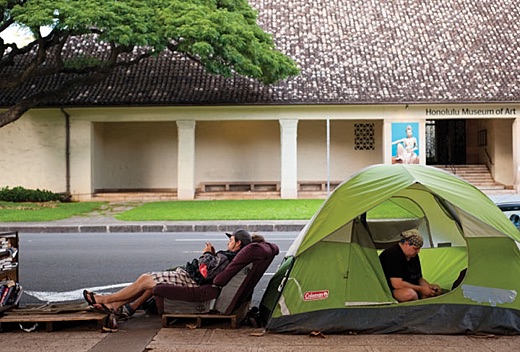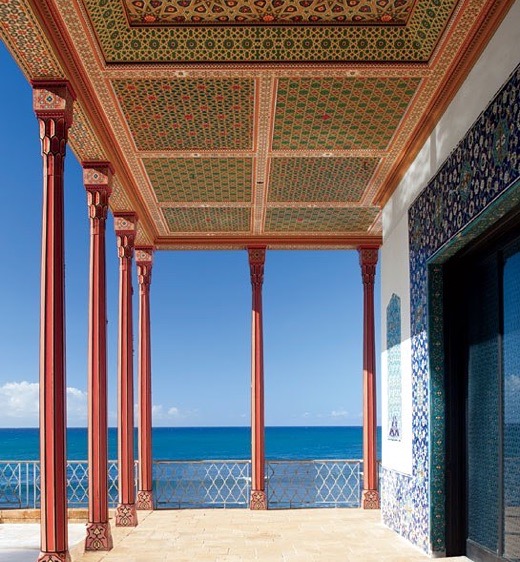SUBHEAD: We need to live in the places we are as if they were the last places on Earth. Because they are.
By Juan Wilson on 7 December 2015 for Island Breath -
(http://islandbreath.blogspot.com/2015/12/time-to-let-civilization-go.html)

Image above: Front of the Honolulu Museum of Art as seen from Thomas Square Park. In the foreground are homelss people living in the park. From (http://www.honolulumagazine.com/Honolulu-Magazine/April-2013-1/Field-Notes-Occupy-Movement-in-Hawaii/).
Over the weekend my wife Linda and I visited Honolulu to see her son, who lives there with his wife and their son. We visited three wonderful museums. The Bishop Museum, the Honolulu Museum of Art and Doris Duke Foundation's Museum of Islamic Art known as Shangri La. Each has a unique world class collection. All are impeccably presented.
The Bishop covers Hawaiian and Polynesian culture and history as well Earth sciences. The Honolulu Museum of Art's collection has representation of world wide art covering over a thousand years as well as contemporary showings.
A special show on display now presents a large collection of the French sculpture of Auguste Rodin. Shangri La presents Duke's collection of Islamic architecture, art and craft that covers centuries and has origins from spanning from Spain across Africa, the Middle East and Asia.
I don't remember another time I enjoyed the experience of museums more.

Image above: The porch of guest house at Doris Duke's Shangri La modeled after a Persian palace in Iran. From (http://dionnerivera.com/odd-eccentric-pieces-and-places/).
Honolulu has recently grown to be the eleventh largest city in America. Most of it is quite new as cities go. It's economy is for the most part fueled by tourism, that is mostly brought to Hawaii by jet fuel. To me that doesn't seem a very solid foundation for the future.
In Honolulu most of the tourism seems to come from Asia, specifically from Japan and more recently China. Young well to do couples from Beijing, in search of a McDonalds, now stroll along the Waikiki Beach sidewalk past homeless aging Vietnam vets and bag ladies. It's an odd clash of civilizations.
We saw many homeless in Honolulu. The climate is easier on the homeless there than than Buffalo or Saint Paul.
Linda and I and her grandson arrived early at the Honolulu Museum of Art so he killed some time in the six acre park across the street called Thomas Square.
The park is a lovely site that has been largely abandoned to the homeless. People lay on the lawn in the shadows of trees in camouflage sleeping bags or next to shopping carts.
At its center is the remains of a large fountain that is about 100 feet in diameter that is surrounded by mature banyan trees. The six inch water main that fed the fountain is shut off. The fountain is empty with a film of pond scum and some litter.

Image above: The fountain in historic Thomas Square in Honolulu at a time when its fountain no longer operates. From (https://alantamayose.wordpress.com/2012/06/02/honolulu/).
Is this the peak of Western Civilization?
This morning, as I was online checking out material for this website while I was listening to Minnesota Public Radio. George Weiblen, a biologist from the University of Minnesota, was being interviewed.
Weiblen was back from a research trip to Papua, New Guinea. For years he has been studying the forests there and the effects of climate change there. New Guinea has the third largest tropical jungle in the world behind the Amazon and Congo.
New Guinea is now going through what Minnesota went through in the 19th century - namely deforestation, or put another way "the arrival of civilization". His point was that it seems a requirement of a place being civilized is that first it is deforested.
I know this sounds pretty obvious, but somehow his presentation of this idea hit a nerve in me. My response is "if that's the case - we don't need so much civilization.
Weiblen added that if we (European settlers )in ) could push the indigenous inhabitants out of the forests of North America and then clear cut them, how could we tell people in Papau, New Guinea, not to do the same.
This moral dilemma is settled for me not by allowing New Guinea forests to be cut, but to require the farmland in Minnesota to be reforested - again, we don't need so much civilization.
The following interview with Peter Snyder, a climate scientist at the University of Minnesota. He discussed the increased occurrence of heat waves and more violent storms and the problems of mitigating heat islands created by massive urban development like twin cities of Minneapolis-Saint Paul.
Some might think a place like Minnesota would be embracing global warming as a improvement to the icy cold that grips the region for much of the year. But the truth is that global warming is residue of our killing everything in our path. It's what civilized human beings.
So we do we don't need so much civilization.
We need to immediately begin the journey back to being indigenous people. That could take the form of living as shoreline fishermen, in pastoral villages, woodland gardens or as nomadic hunter gatherers. But it won't be as urban/suburban car-driving bean counters, baristas or personal assistants.
We need to live in the places we are as if they were the last places on Earth. Because they are.
This is the calm before a storm. It is now that you have a chance to plan and fit out, as you can, the resources you'll need.
The COP21 climate change conference going on in Paris is dwindling down to a fight by corporations for table scraps of resources that are left in the "Third World".
The most "civilized" countries in the world - including France, Germany, England, America, Russia et cetera, seem hell bent on joining in on World War IV in Syria to control what fossil fuel is left in the Middle East.
So we do we need any so much civilization?
.
By Juan Wilson on 7 December 2015 for Island Breath -
(http://islandbreath.blogspot.com/2015/12/time-to-let-civilization-go.html)

Image above: Front of the Honolulu Museum of Art as seen from Thomas Square Park. In the foreground are homelss people living in the park. From (http://www.honolulumagazine.com/Honolulu-Magazine/April-2013-1/Field-Notes-Occupy-Movement-in-Hawaii/).
Over the weekend my wife Linda and I visited Honolulu to see her son, who lives there with his wife and their son. We visited three wonderful museums. The Bishop Museum, the Honolulu Museum of Art and Doris Duke Foundation's Museum of Islamic Art known as Shangri La. Each has a unique world class collection. All are impeccably presented.
The Bishop covers Hawaiian and Polynesian culture and history as well Earth sciences. The Honolulu Museum of Art's collection has representation of world wide art covering over a thousand years as well as contemporary showings.
A special show on display now presents a large collection of the French sculpture of Auguste Rodin. Shangri La presents Duke's collection of Islamic architecture, art and craft that covers centuries and has origins from spanning from Spain across Africa, the Middle East and Asia.
I don't remember another time I enjoyed the experience of museums more.

Image above: The porch of guest house at Doris Duke's Shangri La modeled after a Persian palace in Iran. From (http://dionnerivera.com/odd-eccentric-pieces-and-places/).
Honolulu has recently grown to be the eleventh largest city in America. Most of it is quite new as cities go. It's economy is for the most part fueled by tourism, that is mostly brought to Hawaii by jet fuel. To me that doesn't seem a very solid foundation for the future.
In Honolulu most of the tourism seems to come from Asia, specifically from Japan and more recently China. Young well to do couples from Beijing, in search of a McDonalds, now stroll along the Waikiki Beach sidewalk past homeless aging Vietnam vets and bag ladies. It's an odd clash of civilizations.
We saw many homeless in Honolulu. The climate is easier on the homeless there than than Buffalo or Saint Paul.
Linda and I and her grandson arrived early at the Honolulu Museum of Art so he killed some time in the six acre park across the street called Thomas Square.
The park is a lovely site that has been largely abandoned to the homeless. People lay on the lawn in the shadows of trees in camouflage sleeping bags or next to shopping carts.
At its center is the remains of a large fountain that is about 100 feet in diameter that is surrounded by mature banyan trees. The six inch water main that fed the fountain is shut off. The fountain is empty with a film of pond scum and some litter.

Image above: The fountain in historic Thomas Square in Honolulu at a time when its fountain no longer operates. From (https://alantamayose.wordpress.com/2012/06/02/honolulu/).
Is this the peak of Western Civilization?
This morning, as I was online checking out material for this website while I was listening to Minnesota Public Radio. George Weiblen, a biologist from the University of Minnesota, was being interviewed.
Weiblen was back from a research trip to Papua, New Guinea. For years he has been studying the forests there and the effects of climate change there. New Guinea has the third largest tropical jungle in the world behind the Amazon and Congo.
New Guinea is now going through what Minnesota went through in the 19th century - namely deforestation, or put another way "the arrival of civilization". His point was that it seems a requirement of a place being civilized is that first it is deforested.
I know this sounds pretty obvious, but somehow his presentation of this idea hit a nerve in me. My response is "if that's the case - we don't need so much civilization.
Weiblen added that if we (European settlers )in ) could push the indigenous inhabitants out of the forests of North America and then clear cut them, how could we tell people in Papau, New Guinea, not to do the same.
This moral dilemma is settled for me not by allowing New Guinea forests to be cut, but to require the farmland in Minnesota to be reforested - again, we don't need so much civilization.
The following interview with Peter Snyder, a climate scientist at the University of Minnesota. He discussed the increased occurrence of heat waves and more violent storms and the problems of mitigating heat islands created by massive urban development like twin cities of Minneapolis-Saint Paul.
Some might think a place like Minnesota would be embracing global warming as a improvement to the icy cold that grips the region for much of the year. But the truth is that global warming is residue of our killing everything in our path. It's what civilized human beings.
So we do we don't need so much civilization.
We need to immediately begin the journey back to being indigenous people. That could take the form of living as shoreline fishermen, in pastoral villages, woodland gardens or as nomadic hunter gatherers. But it won't be as urban/suburban car-driving bean counters, baristas or personal assistants.
We need to live in the places we are as if they were the last places on Earth. Because they are.
This is the calm before a storm. It is now that you have a chance to plan and fit out, as you can, the resources you'll need.
The COP21 climate change conference going on in Paris is dwindling down to a fight by corporations for table scraps of resources that are left in the "Third World".
The most "civilized" countries in the world - including France, Germany, England, America, Russia et cetera, seem hell bent on joining in on World War IV in Syria to control what fossil fuel is left in the Middle East.
So we do we need any so much civilization?
.
No comments :
Post a Comment